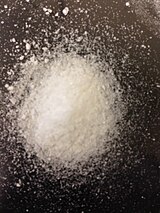Sodium perrhenate
Appearance

| |

| |
| Identifiers | |
|---|---|
3D model (JSmol)
|
|
| ChEMBL | |
| ECHA InfoCard | 100.033.388 |
PubChem CID
|
|
| RTECS number |
|
CompTox Dashboard (EPA)
|
|
| |
| |
| Properties | |
| NaReO4 | |
| Molar mass | 273.194 g/mol |
| Appearance | White crystalline powder |
| Density | 5.39 g/cm3 |
| Melting point | 414 °C (777 °F; 687 K) |
| 103.3 g/100 mL (0 °C) 145.3 g/100 mL (30 °C) 173.0 g/100 mL (50 °C) | |
| Solubility | soluble in ethanol |
| Structure | |
| tetragonal | |
| Hazards | |
| Occupational safety and health (OHS/OSH): | |
Main hazards
|
Oxidizer |
Except where otherwise noted, data are given for materials in their standard state (at 25 °C [77 °F], 100 kPa).
| |
Sodium perrhenate (also known as Sodium Rhenate(VII)) is the inorganic compound with the formula NaReO4 It is a white crystalline solid that is soluble in water. It is a common precursor to rhenium compounds. Its structure resembles that of sodium perchlorate and sodium permanganate.
Preparation
It can be prepared by treatment of rhenium heptoxide with base or by ion exchange from the potassium salt.
Reactions
It reacts with sodium in ethanol to give nonahydridorhenate.[1] and with polysulfide solutions to give tetrathiorhenate. [2]
References
- ^ A. P. Ginsberg, C. R. Sprinkle, Nonahydridorhenate Salts" Inorganic Syntheses 1972, vol. 13, pp. 219–225. doi:10.1002/9780470132449.ch45
- ^ Goodman, J. T.; Rauchfuss, T. B., (2002). "Tetraethylammonium-tetrathioperrhenate [Et4N][ReS4]". Inorganic Syntheses. 33: 107–110. doi:10.1002/0471224502.ch2.
{{cite journal}}: CS1 maint: extra punctuation (link) CS1 maint: multiple names: authors list (link)
Further reading
- Ahluwalia, J. C.; Cobble, J. W. (1 December 1964). "The Thermodynamic Properties of High Temperature Aqueous Solutions. II. Standard Partial Molal Heat Capacities of Sodium Perrhenate and Perrhenic Acid from 0 to 100o". Journal of the American Chemical Society. 86 (24): 5377–5381. doi:10.1021/ja01078a001.
- Dwek, Raymond A.; Luz, Z.; Shporer, M. (1 May 1970). "Nuclear magnetic resonance of aqueous solutions of sodium perrhenate". The Journal of Physical Chemistry. 74 (10): 2232–2233. doi:10.1021/j100909a038.
